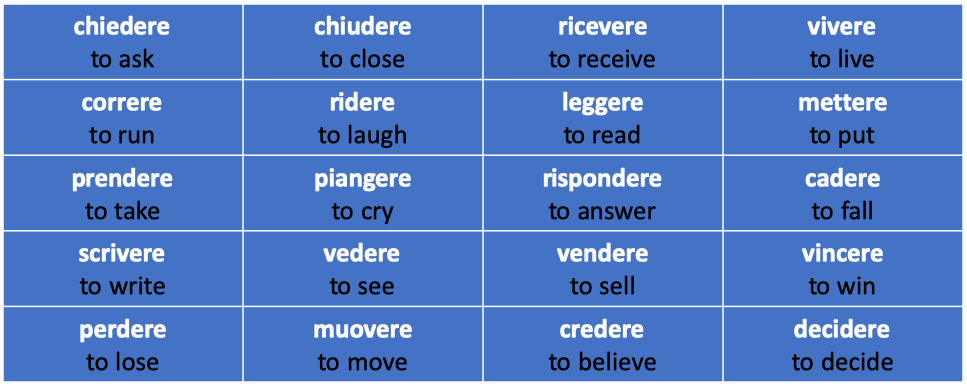Verbs in -ere and -ire
| Listen to the audio file and find the corresponding characters below.
Then click here for the answers.
|
You already know some verbs (guardare, suonare, fare…) that appear here, but you are probably hearing other verbs for the first time (leggere, dormire, etc.). Italian verbs are divided into three patterns of conjugation, following their infinitive form. They can end in –are (first conjugation), in –ere (second conjugation) and in –ire (third conjugation). In this chapter, you are learning the second and third conjugation of regular verbs.
| More verbs To practice vocabulary and pronunciation, use Quizlet.
Verbs in -ere |
| Adverbs of frequency You have already learned about some adverbs of frequency (see Unità 3). You can now learn a few more. To practice vocabulary and pronunciation, use Quizlet.
In Italian, adverbs are usually placed after the verb: Io studio sempre in biblioteca (I always study at the library), Io non sono mai stanco (I am never tired). Since Italian is a bit more liberal than English about placement, some adverbs of frequency may also be found at the beginning of a sentence: this rule especially applies to di solito (usually), ogni tanto (sometimes), qualche volta (sometimes): Di solito/Ogni tanto/Qualche volta dormo in albergo (I usually/sometimes/once in a while sleep in hotel). A big difference in adverbial use between English and Italian is the adverb mai. It needs negative phrases in Italian: Io non studio mai in biblioteca (I never study at the library), Non sono quasi mai stanco (I am hardly ever tired). The adverb mai can be found alone in interrogative sentences and in simple answers (Mangi mai la carne? – Mai Do you ever eat meat? – Never). In any case, these affermative sentences are equivalent to the negative ones (Non mangi mai la carne? – No, non mangio mai la carne Do you ever eat meat? – No, I never eat meat). |
| GRAMMAR
Regular verbs in -ere and -ire
The present tense of regular verbs in –ire verb is formed by dropping the infinitive ending –ire and adding the appropriate endings to the resulting stem (-o, –i, –e, –iamo, –ite, –ono)1Only one form differs from the verbs in –ere: (voi) –ete / –ite.. For example, to form the present tense of partire you first must drop –ire and then add the appropriate endings to the root of the verb (part- is the resulting root), depending on the person speaking. The table below displays the patterns for these verbs, using partire (to leave) as a model.
A significant number of regular verbs of the third conjugation makes their present indicative (except the 1st and 2nd pl. persons – noi and voi) inserting –isc– between the root of the verb and the ending forms. The table below displays the patterns for these verbs, using finire (to finish) as a model.
|
Tasks
|
Practice
Previous > U5 Reading passages, songs, video clips, etc.
Next > Che giorno è oggi?


 Verbs –ire with –isc–
Verbs –ire with –isc–
